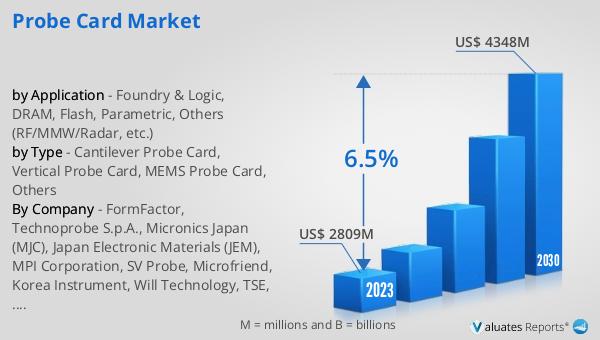What is Global Probe Card Market?
The global probe card market is a crucial component of the semiconductor industry, serving as an interface between the electronic test system and the semiconductor wafer. Probe cards are essential for testing the functionality of semiconductor devices before they are packaged and sold. They ensure that each chip meets the required specifications, thereby maintaining the quality and reliability of electronic products. The market for probe cards is driven by the increasing demand for consumer electronics, advancements in technology, and the need for efficient testing solutions. As semiconductor devices become more complex, the demand for advanced probe cards that can handle higher frequencies and smaller pitches is growing. This market is characterized by rapid technological advancements and a high level of competition among key players. Companies are investing in research and development to innovate and improve the performance of probe cards, which is essential for maintaining a competitive edge. The global probe card market is expected to continue its growth trajectory as the demand for semiconductors in various applications, such as smartphones, computers, and automotive electronics, continues to rise.

Cantilever Probe Card, Vertical Probe Card, MEMS Probe Card, Others in the Global Probe Card Market:
The global probe card market is segmented into various types, including cantilever probe cards, vertical probe cards, MEMS probe cards, and others, each serving specific testing needs in the semiconductor industry. Cantilever probe cards are one of the oldest types and are known for their simplicity and cost-effectiveness. They consist of a set of needles that make contact with the semiconductor wafer, allowing for electrical testing. These cards are typically used for testing larger pitch devices and are favored for their durability and ease of maintenance. However, they may not be suitable for testing high-density or high-frequency devices due to limitations in precision and performance. Vertical probe cards, on the other hand, are designed to address the limitations of cantilever probe cards. They use a vertical arrangement of probes, which allows for more precise contact with the wafer. This design is ideal for testing high-density and high-frequency devices, making them suitable for advanced semiconductor applications. Vertical probe cards offer better performance in terms of signal integrity and are increasingly being adopted in the industry. MEMS (Micro-Electro-Mechanical Systems) probe cards represent the latest advancement in probe card technology. They utilize microfabrication techniques to create highly precise and reliable probes. MEMS probe cards are capable of testing very small pitches and high-frequency devices, making them ideal for cutting-edge semiconductor applications. They offer superior performance in terms of accuracy, repeatability, and longevity, although they tend to be more expensive than traditional probe cards. Other types of probe cards include advanced probe cards designed for specific applications, such as RF (Radio Frequency) testing or high-power testing. These specialized probe cards are developed to meet the unique requirements of certain semiconductor devices, ensuring optimal performance and reliability. As the semiconductor industry continues to evolve, the demand for advanced probe cards that can handle increasingly complex testing requirements is expected to grow. Companies in the probe card market are focusing on innovation and technological advancements to meet the diverse needs of their customers and maintain a competitive edge in the industry.
Foundry & Logic, DRAM, Flash, Parametric, Others (RF/MMW/Radar, etc.) in the Global Probe Card Market:
The global probe card market finds its application in various areas, including foundry and logic, DRAM, flash, parametric, and others such as RF/MMW/Radar. In the foundry and logic segment, probe cards are used to test the functionality of logic devices and integrated circuits. This segment is a major driver of the probe card market, as the demand for high-performance logic devices continues to grow with the increasing adoption of advanced technologies such as artificial intelligence, the Internet of Things, and 5G. Probe cards in this segment are designed to handle high-density and high-frequency testing requirements, ensuring the quality and reliability of logic devices. In the DRAM (Dynamic Random-Access Memory) segment, probe cards are used to test memory devices, which are essential components of electronic products such as computers, smartphones, and servers. The demand for DRAM is driven by the increasing need for high-speed and high-capacity memory solutions in various applications. Probe cards used in this segment are designed to handle the specific testing requirements of memory devices, ensuring their performance and reliability. The flash segment involves the testing of non-volatile memory devices, which are used in a wide range of applications, including data storage, consumer electronics, and automotive systems. Probe cards in this segment are designed to test the functionality and performance of flash memory devices, ensuring their reliability and durability. The parametric segment involves the testing of semiconductor devices to measure their electrical characteristics, such as voltage, current, and resistance. Probe cards used in this segment are designed to provide accurate and reliable measurements, ensuring the quality and performance of semiconductor devices. Other applications of probe cards include RF/MMW/Radar testing, where specialized probe cards are used to test the performance of radio frequency and millimeter-wave devices. These devices are used in various applications, including telecommunications, automotive radar systems, and wireless communication. The demand for probe cards in this segment is driven by the increasing adoption of advanced communication technologies and the need for high-performance RF devices. As the semiconductor industry continues to evolve, the demand for probe cards in these various applications is expected to grow, driving the growth of the global probe card market.
Global Probe Card Market Outlook:
In 2024, the global probe card market was valued at approximately US$ 2,987 million, with projections indicating it could reach around US$ 4,601 million by 2031, growing at a compound annual growth rate (CAGR) of 6.5% during the forecast period from 2025 to 2031. The market is dominated by the top five players, who collectively hold a market share exceeding 64%. The Asia-Pacific region emerges as the largest market, accounting for about 79% of the total market share, followed by North America and Europe, which hold shares of 14% and 5%, respectively. Among the different types of probe cards, MEMS probe cards represent the largest segment, capturing a 59% share of the market. In terms of application, the foundry and logic segment dominates, with a share of approximately 72%. This market outlook highlights the significant growth potential of the probe card market, driven by the increasing demand for advanced semiconductor devices and the need for efficient testing solutions. The dominance of the Asia-Pacific region underscores the importance of this market in the global semiconductor industry, while the strong performance of MEMS probe cards and the foundry and logic segment reflects the ongoing advancements in technology and the growing complexity of semiconductor devices.
| Report Metric | Details |
| Report Name | Probe Card Market |
| CAGR | 6.5% |
| Segment by Type |
|
| Segment by Application |
|
| By Region |
|
| By Company | FormFactor, Technoprobe S.p.A., Micronics Japan (MJC), Japan Electronic Materials (JEM), MPI Corporation, SV Probe, Microfriend, Korea Instrument, Will Technology, TSE, Feinmetall, Synergie Cad Probe, TIPS Messtechnik GmbH, STAr Technologies, Inc., MaxOne, Shenzhen DGT, Suzhou Silicon Test System, CHPT |
| Forecast units | USD million in value |
| Report coverage | Revenue and volume forecast, company share, competitive landscape, growth factors and trends |
